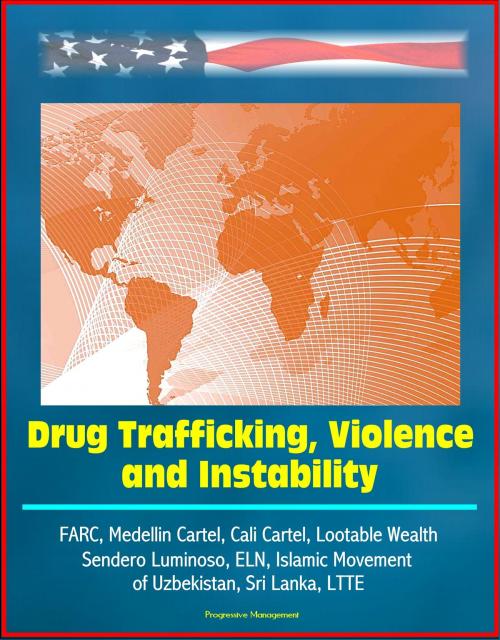Drug Trafficking, Violence, and Instability: FARC, Medellin Cartel, Cali Cartel, Lootable Wealth, Sendero Luminoso, ELN, Islamic Movement of Uzbekistan, Sri Lanka, LTTE
Nonfiction, Social & Cultural Studies, Political Science, Politics, Law Enforcement| Author: | Progressive Management | ISBN: | 9781301712694 |
| Publisher: | Progressive Management | Publication: | March 12, 2013 |
| Imprint: | Smashwords Edition | Language: | English |
| Author: | Progressive Management |
| ISBN: | 9781301712694 |
| Publisher: | Progressive Management |
| Publication: | March 12, 2013 |
| Imprint: | Smashwords Edition |
| Language: | English |
The rationale for this series is a reflection of the ways in which the world of armed groups has changed and is continuing to change, and the impact of these changes on threats and challenges to national and global security. Although challenges posed by various kinds of violent armed groups initially appear highly diverse and unrelated to one another, in fact they all reflect the increasing connections between security and governance—and, in particular, the relationship between poor governance and violent armed groups. The growth in the number of states with capacity gaps, functional holes, and legitimacy deficits helps to explain the resurgence of a new medievalism, and the rise of illegal quasi-governments in localized areas. The irony is that after several decades in which the number of sovereign states represented in the United Nations (UN) has increased significantly, relatively few of these states can truly claim a monopoly on force within their territorial borders.
Violent challengers to the Westphalian state have taken different forms in different parts of the world. These forms include tribal and ethnic groups, warlords, drug trafficking organizations, youth gangs, terrorists, militias, insurgents, and transnational criminal organizations. In many cases, these groups are overtly challenging the state; in others they are cooperating and colluding with state structures while subtly undermining them; in yet others, the state is a passive bystander while violent armed groups are fighting one another. The mix is different, the combinations vary, and the perpetrators of violence have different motives, methods, and targets. In spite of their divergent forms, however, nonstate violent actors share certain qualities and characteristics. As Roy Godson and Richard Shultz have pointed out, "As surprising as it may seem, pirate attacks off Somalia, militias in Lebanon, and criminal armies in Mexico are part of a global pattern and not anomalies." Indeed, these violent armed groups or, as they are sometimes called, violent non-state actors (VNSAs) represent a common challenge to national and international security, a challenge that is far greater than the sum of the individual groups, and that is likely to grow rather than diminish over the next several decades. Although the U.S. military— especially the Air Force and the Navy—still place considerable emphasis on the potential emergence of peer competitors among foreign armed forces, more immediate challenges have emanated not from states but from various kinds of VNSAs.
Most obviously, on September 11, 2001 (9/11), the United States became the target of extremist Islamic terrorist organizations based overseas. It has subsequently had to confront the homegrown offshoots of these groups. Most immigrants to the United States bring with them an allegiance to their new home; a small minority, however, retains allegiance to other entities and causes. Moreover, there are a small but growing number of cases in which American citizens go abroad to fight with extremist groups or to receive training so that they can return and carry out attacks on American soil. Although the killing of Osama bin Laden is seen by some observers as the beginning of the end for al-Qaeda, the threat posed by extremist Islamic terrorist organizations is likely to be far more enduring than any single individual or organization.
The rationale for this series is a reflection of the ways in which the world of armed groups has changed and is continuing to change, and the impact of these changes on threats and challenges to national and global security. Although challenges posed by various kinds of violent armed groups initially appear highly diverse and unrelated to one another, in fact they all reflect the increasing connections between security and governance—and, in particular, the relationship between poor governance and violent armed groups. The growth in the number of states with capacity gaps, functional holes, and legitimacy deficits helps to explain the resurgence of a new medievalism, and the rise of illegal quasi-governments in localized areas. The irony is that after several decades in which the number of sovereign states represented in the United Nations (UN) has increased significantly, relatively few of these states can truly claim a monopoly on force within their territorial borders.
Violent challengers to the Westphalian state have taken different forms in different parts of the world. These forms include tribal and ethnic groups, warlords, drug trafficking organizations, youth gangs, terrorists, militias, insurgents, and transnational criminal organizations. In many cases, these groups are overtly challenging the state; in others they are cooperating and colluding with state structures while subtly undermining them; in yet others, the state is a passive bystander while violent armed groups are fighting one another. The mix is different, the combinations vary, and the perpetrators of violence have different motives, methods, and targets. In spite of their divergent forms, however, nonstate violent actors share certain qualities and characteristics. As Roy Godson and Richard Shultz have pointed out, "As surprising as it may seem, pirate attacks off Somalia, militias in Lebanon, and criminal armies in Mexico are part of a global pattern and not anomalies." Indeed, these violent armed groups or, as they are sometimes called, violent non-state actors (VNSAs) represent a common challenge to national and international security, a challenge that is far greater than the sum of the individual groups, and that is likely to grow rather than diminish over the next several decades. Although the U.S. military— especially the Air Force and the Navy—still place considerable emphasis on the potential emergence of peer competitors among foreign armed forces, more immediate challenges have emanated not from states but from various kinds of VNSAs.
Most obviously, on September 11, 2001 (9/11), the United States became the target of extremist Islamic terrorist organizations based overseas. It has subsequently had to confront the homegrown offshoots of these groups. Most immigrants to the United States bring with them an allegiance to their new home; a small minority, however, retains allegiance to other entities and causes. Moreover, there are a small but growing number of cases in which American citizens go abroad to fight with extremist groups or to receive training so that they can return and carry out attacks on American soil. Although the killing of Osama bin Laden is seen by some observers as the beginning of the end for al-Qaeda, the threat posed by extremist Islamic terrorist organizations is likely to be far more enduring than any single individual or organization.















